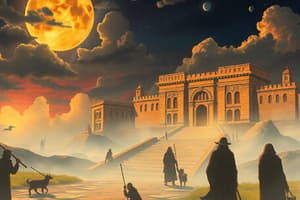Podcast
Questions and Answers
Which of the following best describes a primary source?
Which of the following best describes a primary source?
- A textbook summarizing historical events
- A documentary about a significant event
- A diary written by a historical figure (correct)
- A newspaper article analyzing an event
Primary sources are created after an event has occurred.
Primary sources are created after an event has occurred.
False (B)
What is meant by 'historical significance'?
What is meant by 'historical significance'?
The importance of an event in shaping history.
An example of a secondary source is a __________, which analyzes past events.
An example of a secondary source is a __________, which analyzes past events.
Match the terms with their definitions:
Match the terms with their definitions:
Flashcards
Historical Thinking
Historical Thinking
The ability to analyze historical events in order to understand the past, present and future.
Inquiry Skills
Inquiry Skills
Skills used by historians to research and analyze historical events. This includes analysis of sources, interpretation of evidence, and formulating arguments.
Continuity and Change
Continuity and Change
The ongoing existence of certain elements in history alongside the gradual changes over time within a society or a specific event.
Cause and Consequence
Cause and Consequence
Signup and view all the flashcards
Historical Significance
Historical Significance
Signup and view all the flashcards
Study Notes
Historical Thinking Skills
- Historical thinking involves inquiry, considering continuity and change over time, identifying causes and consequences, evaluating historical significance, understanding ethical dimensions, and adopting a historical perspective when analyzing events.
Inquiry Skills
- Historical inquiry involves questioning, researching, evaluating evidence, and drawing conclusions from historical sources.
Continuity and Change
- Historians examine how events and societies remain the same over time and how they evolve.
Cause and Consequence
- Understanding historical events requires looking at the reasons behind them (causes) and the results of these events (consequences).
Historical Significance
- Evaluating the importance of historical events requires considering their impact and relevance to individuals, societies and, or the world.
Ethical Dimensions
- Considering the moral and ethical implications of historical events and decisions is crucial.
Historical Perspective
- Understanding events from the viewpoint and beliefs of the people who lived during that time is essential to avoiding present-day biases.
Primary Sources
- Primary sources provide direct evidence of historical events, created by those involved or present.
- Examples include artifacts, journals, letters, photographs, and oral histories.
Secondary Sources
- Secondary sources analyze and interpret primary sources, written by historians or other scholars after the event.
- They utilize primary sources to support their claims.
Bias
- Bias represents a prejudice or preconceived judgment (positive or negative).
- Authors of secondary sources, in particular, have biases that can influence their interpretations of events.
Perspective
- Perspective involves the viewpoints and beliefs of individuals during a certain historical period.
- Understanding historical context is important to comprehend perspectives.
Studying That Suits You
Use AI to generate personalized quizzes and flashcards to suit your learning preferences.



